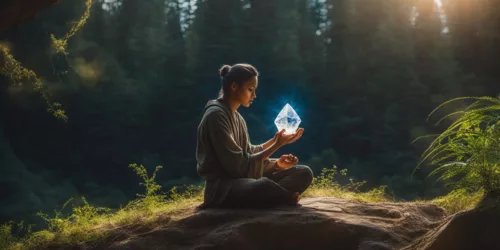Exploring Labyrinths and Mindfulness for Inner Peace
Welcome to our exploration of labyrinths and how they intertwine with the practice of mindfulness. Labyrinths have long been revered for their ability to facilitate healing, meditation, and emotional growth. By combining the ancient art of labyrinth walking with the principles of mindfulness, we can embark on a transformative journey of self-discovery and inner peace.
As we delve into the world of labyrinths, we will uncover the various types of labyrinths and their cultural significance. From the Classical or Cretan Labyrinth to the Chakra-Vyuha Labyrinth, each labyrinth offers a unique experience and symbolism that can deepen our mindfulness practice. Whether constructed from turf, rock, hedge, or another material, the labyrinth’s design holds a special place in enhancing our journey towards mindfulness.
In the following sections, we will explore the practice of labyrinth walking meditation and how it can cultivate a heightened sense of awareness and introspection. We will also uncover the transformative power of labyrinths, understanding how they serve as therapeutic tools and artistic expressions that promote emotional healing and balance. Together, let’s embark on this mindful journey through labyrinths.
Key Takeaways:
- Labyrinths offer more than just a physical journey – they promote meditation and mindfulness, reducing anxiety and improving mood.
- Walking a labyrinth combines physical movement, spiritual symbolism, and mindfulness, fostering awareness and deep insights.
- Labyrinths symbolize spiritual growth, pilgrimage, and self-discovery, providing solace and guidance during times of change.
- Exploring labyrinths facilitates emotional healing, decreases stress, and promotes peace and balance.
- The design of a labyrinth holds cultural significance and enhances the mindfulness journey.
The Practice of Labyrinth Walking Meditation
Labyrinth walking meditation is a unique practice that combines physical movement, spiritual symbolism, and mindfulness. Unlike traditional sitting meditation, labyrinth walking meditation involves walking a winding path while focusing on breath, bodily sensations, and the surrounding environment.
The labyrinth itself holds deep meaning as a metaphor for the inner journey of self-exploration. As individuals walk the labyrinth, they surrender decision-making and fully immerse themselves in the present moment. This practice cultivates awareness, deepens sensory experiences, and brings forth profound insights.
Walking meditation in a labyrinth can serve various purposes. It can be a space for personal reflection, allowing individuals to gain clarity and insight into their lives. It can also be a means of symbolic narrative exploration, where the labyrinth path represents the twists and turns of one’s life journey.
Moreover, labyrinth walking meditation can be a powerful tool for emotional release and healing. The rhythmic movement and intentional focus help individuals connect with their emotions, release tension, and find solace. Additionally, the act of walking stimulates different regions of the brain, fostering brain health and enhancing cognitive function.
The labyrinth experience typically involves a structured process. It begins with preparation, setting an intention or question to explore during the walk. As individuals enter the labyrinth, they surrender themselves to the path, trusting in its guidance. Upon reaching the center, they engage in contemplation, allowing space for reflection and deep connection. Finally, they mindfully return, integrating their experiences and insights into their lives.
Labyrinths can be found in various locations, including churches, retreat centers, parks, and private properties. For those interested in experiencing labyrinth walking meditation, online directories and local meditation or spiritual centers can be valuable resources for finding labyrinths nearby.
Labyrinth Tips and Techniques
Here are a few tips and techniques to enhance your labyrinth walking meditation practice:
- Set an intention or question before entering the labyrinth to guide your journey.
- Walk at your own pace, allowing your body to synchronize with your breath and the rhythm of your steps.
- Stay present and mindful, focusing on your senses and the sensations of walking.
- Use the labyrinth as a space for emotional release and healing, expressing any feelings that arise during the practice.
- Practice gratitude as you move through the labyrinth, acknowledging the insights and experiences that come to you.
- Experiment with different labyrinth designs and styles to explore the unique energy and symbolism each one offers.
Remember, the labyrinth is a sacred space for self-discovery and inner peace. Embrace the practice with an open heart and an open mind, and allow it to guide you on your journey of mindfulness and personal transformation.
The Transformative Power of Labyrinths
Labyrinths hold deep symbolism, representing spiritual growth, pilgrimage, and self-discovery. For individuals who struggle with traditional sitting meditation, walking a labyrinth offers a compelling alternative practice for mindfulness. It enables us to tap into our creativity and intuition while providing a therapeutic tool that can be used in couple and family therapy. The benefits of labyrinths extend beyond the mind, as they have been associated with reducing stress, eliciting the body’s relaxation response, and fostering a sense of peace and balance.
Walking a labyrinth is a grounding experience, connecting us to something greater than ourselves. During moments of intense change or difficulty, the labyrinth can provide solace and serve as a guide. These transformative spaces can be found in various settings, including churches, nature centers, museums, and colleges. They offer individuals a safe and sacred opportunity to clear their minds, de-stress, and access their inner wisdom.
Not only do labyrinths have a profound impact on our well-being, but they also inspire artistic expressions. Through their intricate designs and the act of walking the labyrinth, we engage in a form of creative expression that nurtures our soul. The labyrinth becomes a canvas for our emotions, allowing us to journey through our inner landscape and cultivate emotional healing.
Whether seeking emotional healing, mindfulness practices, or artistic explorations, labyrinths present transformative opportunities. These ancient pathways continue to be relevant today, serving as powerful therapeutic tools in our fast-paced and often chaotic world. As we embark on a labyrinth journey, let us open ourselves to the profound benefits that lie within its symbolic walls.
FAQ
What is labyrinth meditation?
Labyrinth meditation is a form of walking meditation where individuals focus on their breath, bodily sensations, and the environment while walking a labyrinth. It combines physical movement, spiritual symbolism, and mindfulness to promote self-exploration and inner peace.
What are the benefits of walking a labyrinth?
Walking a labyrinth offers numerous benefits, including reducing anxiety and improving mood, promoting mindfulness and self-awareness, fostering emotional healing, providing a sense of ritual and structure, and enhancing social support and connection.
Where can I find labyrinths to walk?
Labyrinths can be found in various locations, such as churches, retreat centers, parks, and private properties. Online directories and local meditation/spiritual centers are helpful resources for finding labyrinths near you.
How do I practice labyrinth walking meditation?
To practice labyrinth walking meditation, begin by setting an intention, focus on your breath and bodily sensations while walking the labyrinth’s winding path, allow yourself to be fully present in the moment, and reflect on your experiences and insights during and after the walk.
Can labyrinths be used for therapy?
Yes, labyrinths can be used as a therapeutic tool. They have been used in couple and family therapy, as well as for emotional release and brain health. Labyrinths provide a safe and symbolic space for exploration, healing, and personal growth.






